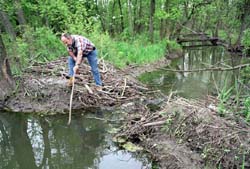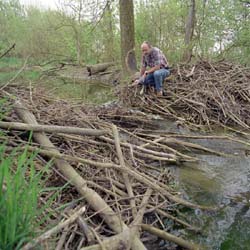 |
|
Those 'Dam' Beavers by Rod Walton
Along with bison, beavers typify the movement west by Americans during
the mid-1800s. Along with bison, beavers were there first.
Pioneers found beaver colonies along virtually all the streams and rivers in the
plains, including Illinois, and soon professional trappers followed to reap the
rich harvest of hides to satisfy the appetites of Easterners and Europeans.
Hides were used for vests, trimmings, and most importantly, top hats.
Before that time, Native Americans held the beaver in high regard. An early
Indian word to describe the trait of affability was “beaver-like.” Beavers are,
indeed, an affable species. Perhaps they are just too busy to be unpleasant.
Beavers are the largest rodents in North America, weighing
in at 30 to 40 pounds, although individuals over 80 pounds
are not uncommon. They are vegetarians and eat the young
bark and wood of willows and cottonwoods that grow along
streams and lakes. Unlike many large mammals, their
aquatic habits limit their range to these surface waters.
Beavers have earned their reputation as busy and ambitious
engineers. They harvest prodigious amounts of wood for
food, then use the leftovers to build lodges and dams.
They’ve been known to gnaw partway through a large tree
and then wait for a passing wind gust to blow it over for
them. Typically, they build their lodges first, with the small
entrance at water level, then go a short way downstream
and build a dam of small saplings and limbs, fortified with
mud. The rise in water level behind the dam then obscures
the entrance to the lodge, creating a safe and secure winter
refuge for the beaver families.
The dam-building has fortuitous consequences for the rest of the ecosystem
as well. The water backed up behind a beaver dam creates diverse habitat
for many other plants and animals. The water can even help to recharge
groundwater in underlying aquifers.
Because Fermilab has lots of surface water and very flat topography, beavers
frequently build dams here, and they can have profound effects upstream.
A typical dam that holds back a foot of water can result in acres of previously
dry land becoming a pond bottom. Sometimes the extra water invades our
technical spaces or just seeps into basements, causing various amounts
of damage.
Jim Kalina, of the Roads and Grounds department
in Fermilab’s Facilities Engineering Services
Section, occasionally must trap beavers whose
earthworks are causing problems for laboratory
operations.
“When we first started removing beavers, in the
mid-1970’s, we trapped as many as thirty animals
each year,” Kalina said. “But now, we only have to
remove around six.”
Beavers are a protected species, and the Illinois
Department of Natural Resources requires a permit
to trap problem animals. Kalina pointed out that
Fermilab has about six large beaver families in
Lake Law and the Main Ring Ponds.
“They have no adverse effects,” Kalina said,
“so we leave them alone.”
Formerly endangered,
these natural engineers
are plentiful in Illinois—
and on the Fermilab site
Kalina also noted that Fermilab is constantly
experimenting with other remedies. Sometimes
a long pipe that penetrates the dam, and
continuously “drains” the beaver pond downstream,
works—at least for a while. But often the beaver
just moves 50 feet downstream and builds another
dam. Various wire and mesh “beaver-deceivers”
have been designed to exclude beavers from
choice dam sites while allowing water to flow freely.
Unfortunately, the industry and imagination of the
beavers usually exceeds that of the humans, and
such measures have met with inconsistent results.
“You have to give them a lot of credit and respect,”
Kalina said. “They are very good engineers and
builders, and they don’t give up.”
Beavers were actually exterminated in Illinois
in the late nineteenth century, but attempts at
re-introduction during the thirties were eventually
successful. The state’s beaver population is healthy
again, as Fermilab can attest.
|

 However, beavers and the technical handiwork of humans don’t always mix
well. Beavers can be a nuisance when they gnaw down trees or shrubs that
humans appreciate, or inundate a “desirable” plant community, or when their
dam-building activities create high water in places where we don’t want it—
places like an accelerator enclosure, for instance.
However, beavers and the technical handiwork of humans don’t always mix
well. Beavers can be a nuisance when they gnaw down trees or shrubs that
humans appreciate, or inundate a “desirable” plant community, or when their
dam-building activities create high water in places where we don’t want it—
places like an accelerator enclosure, for instance.